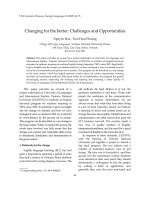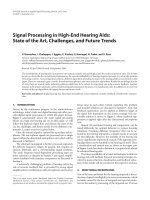black families at the crossroads challenges and prospects
Bạn đang xem bản rút gọn của tài liệu. Xem và tải ngay bản đầy đủ của tài liệu tại đây (2.4 MB, 408 trang )
TeAM
YYePG
Digitally signed by TeAM YYePG
DN: cn=TeAM YYePG, c=US,
o=TeAM YYePG, ou=TeAM
YYePG, email=
Reason: I attest to the accuracy
and integrity of this document
Date: 2005.02.03 22:08:15
+08'00'
J. 00.fm.i-xxxii 8/11/04 3:45 PM Page i
J. 00.fm.i-xxxii 8/11/04 3:45 PM Page ii
Black Families
at the Crossroads
J. 00.fm.i-xxxii 8/11/04 3:45 PM Page iii
Leanor Boulin Johnson
Robert Staples
Foreword by Robert B. Hill
J. 00.fm.i-xxxii 8/11/04 3:45 PM Page iv
Black Families at
the Crossroads
Challenges and Prospects
Revised Edition
J. 00.fm.i-xxxii 8/11/04 3:45 PM Page v
Copyright © 2005 by John Wiley & Sons, Inc. All rights reserved.
Published by Jossey-Bass
A Wiley Imprint
989 Market Street, San Francisco, CA 94103-1741 www.josseybass.com
No part of this publication may be reproduced, stored in a retrieval system, or transmitted
in any form or by any means, electronic, mechanical, photocopying, recording, scanning,
or otherwise, except as permitted under Section 107 or 108 of the 1976 United States
Copyright Act, without either the prior written permission of the Publisher, or authoriza-
tion through payment of the appropriate per-copy fee to the Copyright Clearance Center,
Inc., 222 Rosewood Drive, Danvers, MA 01923, phone: 978-750-8400, fax: 978-646-8600,
or on the Web at www.copyright.com. Requests to the Publisher for permission should be
addressed to the Permissions Department, John Wiley & Sons, Inc., 111 River Street,
Hoboken, NJ 07030, phone: 201-748-6011, fax: 201-748-6008, e-mail: permcoordinator
@wiley.com.
Jossey-Bass books and products are available through most bookstores. To contact Jossey-
Bass directly, call our Customer Care Department within the U.S. at 800-956-7739 or
outside the U.S. at 317-572-3986, or fax to 317-572-4002.
Jossey-Bass also publishes its books in a variety of electronic formats. Some content that
appears in print may not be available in electronic books.
Library of Congress Cataloging-in-Publication Data
Johnson, Leanor Boulin, date
Black families at the crossroads : Challenges and prospects /
Leanor Boulin Johnson, Robert Staples.—Rev. ed.
p. cm.
Rev. ed. of: Black families at the crossroads / Robert
Staples, Leanor Boulin Johnson. 1st ed. c1993.
Includes bibliographical references and index.
ISBN 0-7879-7222-3 (alk. paper)
1. African American families. I. Staples, Robert.
II. Staples, Robert.
Black families at the crossroads. III. Title.
E185.86.S698 2004
306.85’089’96073—dc22 2004010951
Printed in the United States of America
SECOND EDITION
PB Printing 10987654321
J. 00.fm.i-xxxii 8/11/04 3:45 PM Page vi
Foreword ix
Robert B. Hill
Preface to the Revised Edition xvii
Preface to the First Edition xxi
Acknowledgments xxvii
1 History as Fact and Fiction 1
2 Studying Black Families 31
3 Work and Money: The Struggle 59
4 Patterns of Sexual Intimacy 93
5 Singlehood and Partner Selection 125
6 Gender Roles and Male Sexism 155
7 Marital Patterns and Interactions 177
8 The Challenges of Parenting 213
9 Kinship and Community Support 245
10 Social Change, Challenges, and Prospects 277
Selected Readings 311
References 313
About the Authors 357
Name Index 359
Subject Index 369
Contents
vii
J. 00.fm.i-xxxii 8/11/04 3:45 PM Page vii
J. 00.fm.i-xxxii 8/11/04 3:45 PM Page viii
Once again, Leanor Johnson and Robert Staples, who combine
more than sixty years of writing and research as family sociologists,
have produced a work that greatly enhances the understanding of
the complexity and diversity in the functioning of Black families
today. This revised edition provides rare insights regarding how the
cultural values, attitudes, and aspirations of African American fam-
ilies interact with structural conditions and social policies to pro-
duce a wide range of positive and negative outcomes. Thus, this
work makes many important contributions to our knowledge about
external and internal forces that affect African American families.
First and foremost, this is a book about the institution of the
Black family. There is a widespread tendency to misrepresent many
works that concentrate on problems, such as unemployment, pov-
erty, and adolescent pregnancy, as studies of Black families when
actually the individual or community is the focus of study. It is for
this reason that research in which Black families are the primary
unit of analysis, as in this book, continues to comprise only a tiny
fraction of the studies of African Americans.
Second, a historical perspective is incorporated throughout this
work. A major deficiency in most other studies of Black families is
their ahistorical approach. Over a century ago, W.E.B. Du Bois ar-
gued that researchers could not adequately study Black people with-
out placing their work within a historical and cultural context.
Foreword
ix
J. 00.fm.i-xxxii 8/11/04 3:45 PM Page ix
xFOREWORD
Thus, Johnson and Staples begin not with slavery in America but
with family life on the continent of Africa. They make a strong case
for understanding how African cultural continuities or adaptations
contribute to the structure and functioning of contemporary African
American families. This discussion is enriched by the inclusion of
recent historical reinterpretations on the nature of North Ameri-
can slavery.
Third, this book applies a framework for studying Black families
that integrates conceptual models from various perspectives.
Another major shortcoming of most Black family studies is their ad
hoc nature and the lack of a unifying theoretical or conceptual
approach. The authors adopt as a primary perspective the Afrocen-
tric model, which concentrates on the impact of African cultural
continuities on contemporary African Americans. But they also
incorporate propositions from internal colonialism, historical mate-
rialism, assimilation theory, exchange theory, and Black feminist the-
ory to support their explanations.
Fourth, unlike most other Black family studies, this work places
its primary focus on the internal processes that affect all class strata
among African American families. Many researchers think that they
understand “the” Black family after studying only the “lower-class”
or “underclass” subgroups. The Black working class, middle class, and
upper class have been largely ignored in the mainstream family lit-
erature. It is also unfortunate that because of the undue concentra-
tion on single-parent families, there continue to be very few studies
of two-parent families among Blacks. Moreover, while there is an
obsession with families that break up, there have been few studies of
the processes that can lead to marriage (such as dating or courtship)
or factors that help to sustain marriages among African Americans.
Johnson and Staples have contributed disproportionately to such
progressive research. Since this book is replete with important in-
sights about African American families, it is important to underscore
some of them.
J. 00.fm.i-xxxii 8/11/04 3:45 PM Page x
Their discussion of the Atlantic Creoles (persons of African and
European lineage), who came to North America as indentured ser-
vants prior to the development of the American slave trade, is
enlightening. The Dutch West India Company transported these
Creoles, who served as multilingual traders between Africa, North
and South America, and Europe to the New World. Most of them
obtained their freedom at the end of their period of indenture after
paying off any debts. Their role provides a basis for understanding
how Blacks who remained free throughout the antebellum period
were able to own property and businesses and establish self-help
institutions (such as churches, schools, hospitals, credit unions,
insurance companies, banks, orphanages, and homes for the elderly)
that contributed to the growth of the Black middle class.
According to conventional wisdom, house slaves were an elite
group who had easier work than field slaves. Yet the authors inform
us that this romanticized view of household work is not accurate. On
the contrary, many studies reveal that most house slaves had to jug-
gle multiple tasks and laborious work responsibilities (such as clean-
ing, laundering, and cooking) from sunup to long after sundown. For
these reasons, many slaves preferred field work to household duties.
This book also reminds us of how immigration policies histori-
cally had adverse effects on the economic well-being of Black fami-
lies. Few Americans realize that Northern firms aggressively recruited
immigrants from European countries to prevent those jobs from go-
ing to large numbers of newly freed blacks whom they feared would
soon flood their cities. Poor economic conditions in Europe at the
time (such as the potato famines) helped to accelerate the exodus of
many immigrants. Thus, it was only during World Wars I and II,
when immigration from Europe was curtailed, that Black men and
women made their strongest employment and occupational gains.
In addition to the impact of European immigration, the authors shed
light on Caribbean Black migrants’ quest for economic stability in
America and its implications for native Black Americans.
Foreword xi
J. 00.fm.i-xxxii 8/11/04 3:45 PM Page xi
xii FOREWORD
Like other scholars, Johnson and Staples find working wives to be
more important to the economic viability of Black than White fam-
ilies, since they contribute more to the total income of their families.
But contrary to conventional wisdom, Black husbands have more pos-
itive attitudes than White husbands do toward wife employment.
And the sense of job competence is greater among Black husbands
with working wives than among White husbands with working wives.
In addition, there is more role flexibility and shared decision making
in Black families with dual earners than among White families with
dual earners.
Black youth are more likely to engage in premarital sexual activ-
ity at earlier ages than White youth. But the authors offer social and
economic explanations for such early sexuality in the place of alle-
gations of unbridled biological impulses. One factor is the more
prominent role of sexual socialization from same-sex peer groups
among Black than White youth, especially in low-income families.
Overcrowded living conditions are also more likely to expose lower-
income young people than youth in middle-income families at ear-
lier ages to sexual behavior among adults.
It is often asserted that because of the greater prevalence of
female-headed families, Black males reared in those families are
likely to have a higher incidence of homosexuality than White
males. Yet the authors find no credible research that supports such
beliefs. On the contrary, they cite studies that found that Black
males are more comfortable around homosexuals than White males
are and do not perceive them as a threat to their manhood. More-
over, they find no empirical support for the claim that Black women
are more prone to lesbianism than White women due to the dis-
proportionate shortage of Black men.
This work also strongly challenges the widespread belief that
boys reared in female-headed families are not socialized into male
roles. In fact, Black boys have numerous male role models to choose
from inside and outside their families. They develop masculine iden-
tities from male relatives (such as nonresident fathers, grandfathers,
J. 00.fm.i-xxxii 8/11/04 3:45 PM Page xii
uncles, and older brothers) and male nonrelatives (including neigh-
bors, coaches, ministers, teachers, and tutors). Even in two-parent
families, boys may emulate their fathers in some areas and other
men in other aspects. More important, Johnson and Staples also cite
studies that reveal that mothers can communicate appropriate male
roles to their sons. They identify successful men (such as Dr. Ben
Carson and Ralph Bunche) who were reared in families headed by
Black women.
The authors reject the narrow definitions of Black fatherhood
that minimize their expressive contributions to children and of
Black motherhood that marginalize their provider role. They con-
clude, “Given that Black fathers and mothers deem it appropriate
to interchange or share the provider and expressive roles, the father-
daughter and mother-son relationships are just as important for
understanding child development and aspirations as are the mother-
daughter and father-son relationships.” Thus, they underscore the
need for more studies of the impact of Black fathers on the devel-
opment of their daughters and how Black mothers influence the
development of their sons.
Some feminists contend that singlehood is a viable alternative to
marriage for African Americans. Yet Johnson and Staples argue that
most Blacks perceive their singleness not as a preferred option but as
a status forced on them by certain conditions in American life. They
contend that many Blacks have found alternative lifestyles charac-
terized as family substitutes, such as open marriage, communal living,
and heterosexual cohabitation, to be less desirable than formal mar-
riage. However, they readily acknowledge that the unavailability of
sufficient numbers of marriageable males, due to the institutional dec-
imation of Black men, continues to be a major obstacle for many
Blacks to achieve their desired goal of marriage.
Regarding mate selection, Black men are reported to give pref-
erence to light-skinned women, while light-skinned Black women
find dark-skinned men more desirable, especially since the 1960s.
Moreover, cross-racial dating on college campuses is inversely related
Foreword xiii
J. 00.fm.i-xxxii 8/11/04 3:45 PM Page xiii
xiv FOREWORD
to the number of Blacks in the student body. Interracial mating de-
creases as the number of Black students increases. But while Black
male–White female relationships continue to comprise the major-
ity of Black interracial marriages, marriages involving White males
and Black females are sharply increasing.
Although noncustodial Black fathers typically are portrayed as
uncaring and uninvolved, many studies have shown that they have
regular contact with their children and make many contributions
to their well-being. Moreover, Black fathers are more likely to raise
their children as single parents than White fathers are. Thus, many
nonresident Black fathers perform important expressive functions
and provide a broad range of support to their children and families.
Although the Black extended family has lost some of its influ-
ence, the authors note that it continues to play an important role
in the survival and upward mobility of African American families.
It is responsible for transmitting the family’s cultural traditions and
history, reducing child abuse, providing long-term support to teen
mothers, assisting adult single parents during crises, and rearing kin
children when their biological parents are not able to care for them.
While most grandmothers and aunts care for their kin without gov-
ernment intervention, there has been a surge of Black children in
the foster care system who are reared by kin due to the onset of
HIV/AIDS, drug abuse, and incarceration of fathers and mothers.
Unfortunately, kinship care providers receive lower stipends and
fewer social services than nonrelated caregivers.
This book has important implications for many family policies.
Since the Bush administration has placed a high priority on pro-
moting marriage among low-income couples, this work should be
carefully reviewed to understand the social, economic, and cultural
dynamics of male-female relationships before implementing these
programs. For example, while most low-income Black women prefer
marriage, they nevertheless apply a cost-benefit analysis: Do the
costs of marriage outweigh its benefits? Moreover, since many of
these women have experienced or observed unsatisfying and volatile
J. 00.fm.i-xxxii 8/11/04 3:45 PM Page xiv
marriages, culturally insensitive programs may have little success in
convincing them to get into another relationship.
The future prospects for strengthening African American fam-
ilies will be greatly enhanced only when individual and institutional
barriers to the development of children and families of color are
removed; policies and programs are developed that are specifically
targeted to families rather than individuals; and African American
national organizations, churches, community-based groups, histor-
ically Black colleges and universities, and scholars play major roles
in the planning, development, implementation, and evaluation of
these policies and programs.
This outstanding work by Staples and Johnson should be read
by professionals and laypeople in all fields who seek to enhance the
well-being of Black families.
Robert B. Hill
Washington, D.C.
Foreword xv
J. 00.fm.i-xxxii 8/11/04 3:45 PM Page xv
To my mother, Anna Staples, for her love
and devotion to the end of her life.
—Robert Staples
To the memory of my parents,
Herbert Fitzgerald Constantine Boulin
and Linda Louise Rashford Boulin,
who for forty years demonstrated
the glory and warmth of love.
And to my only grandchild,
Asia Denise Mims Johnson, who
never knew her maternal grandparents
but will always feel their love.
—Leanor Boulin Johnson
J. 00.fm.i-xxxii 8/11/04 3:45 PM Page xvi
In the twelve years since the first edition of this book was published,
there was an economic boom during the 1990s that brought about
a marked improvement in the lives of Black families. The effects of
those improvements are likely to erode in the economic recession
of the first decade of the twenty-first century. Our revised chapters
cover mostly the improvements, not the declines, since they are too
recent to be reflected as a pattern in current census data and empir-
ical studies. Approximately one-fourth of the book has been revised,
mostly to take into account newer research studies and more recent
census and economic data. Our basic conceptualization of Black
family structure and dynamics remains the same, although the inter-
vening twelve years gave us time to reflect on enhancements to the
original book.
Among the major changes to the first edition are different his-
torical interpretations of the nature of North American slavery and
its impact on the family life of the bondsmen. In our inclusion of
Black immigrant families, we describe the neoassimilation model and
how, unlike the classic assimilation model, it is applicable to fami-
lies that face both racial barriers and adjustment to different cultures.
The largest group of Black immigrants comes from the Caribbean
region, and their voluntary migration informs our understanding of
the quest for economic stability among native-born Black American
families whose ancestors came to North America in chains.
Preface to the Revised Edition
xvii
J. 00.fm.i-xxxii 8/11/04 3:45 PM Page xvii
xviii PREFACE TO THE REVISED EDITION
Included in the significant changes of the past decade are cul-
tural patterns and their impact on aspects of the family. Hip-hop
music, after withstanding two decades of predictions of its immi-
nent demise, has now become the dominant music of American
youth, with important implications for gender relations and equity.
We examine its form for the tendency to be misogynist and profane.
Some might attribute its stylistic traits as contributing to an increase
in liberalized sexual attitudes and behavior. To provide a better
understanding of America’s sexual liberation in the past decade, we
look at some of the most recent research on Black sexuality and
develop an expanded discussion of the AIDS crisis in lower-income
Black communities.
Finally, we have considerably revised our final chapter on the
problems and prospects for Black families in the twenty-first century.
Despite the progress of the 1990s, significant changes in Black fam-
ilies await more positive improvements in the situation of Black
males. Large numbers of Black men cannot enact the conventional
roles of husband and father due to the problems of substance abuse,
imprisonment, unemployment, and low skills. Black women con-
tinue to make progress on the educational, employment, and income
fronts, only to discover that what awaits them is out-of-wedlock
births, single parenthood, and an unmarried life because there are
few eligible males willing and able to take on the responsibility of
forming and maintaining a family. This chapter examines those eco-
nomic trends.
Also in the final chapter, we examine the welfare reform policy
passed during the boom years of the 1990s and the flaws of a policy
that deprives women and children of a safety net during economic
decline. The lack of universal health care, available in most other de-
veloped nations, will be one of the greatest challenges for Black fam-
ilies in the years ahead, as will be the quest for affordable housing in
America’s largest and most expensive cities. Those who entered the
labor market during the 1980s and 1990s, Generation X, are projected
to be the first cohort who will have a lower standard of living than
J. 00.fm.i-xxxii 8/11/04 3:45 PM Page xviii
their parents. For Blacks who are part of Generation X, this projec-
tion is far more likely to be realized. In an era when the American
government is running a large deficit, increasing the amount spent
on war and prisons while assigning secondary funding to social and
educational programs, the challenges are formidable.
August 2004 Leonor Boulin Johnson
Scottsdale, Arizona
Robert Staples
San Francisco, California
Preface to the Revised Edition xix
J. 00.fm.i-xxxii 8/11/04 3:45 PM Page xix
J. 00.fm.i-xxxii 8/11/04 3:45 PM Page xx
This collaboration grew out of our awareness that there is no cen-
tral source of information on the Afro-American family. Antholo-
gies on Black families lack the systematic analysis and consistency
of an authored book. Other books are too specialized in the topics
discussed or neglect the institutional role of Afro-American fami-
lies. We both have the advantage of having been specifically trained
in the sociology of the family and have taught a variety of classes
on the family at different universities. Together, we combine more
than fifty years of teaching about and studying Black American fam-
ilies, our primary specialization being in family sociology. Because
we had collaborated on a number of projects over the years,
belonged to the same professional organizations, and shared a sim-
ilar perspective on the Afro-American family, our collaboration on
this project seemed natural.
No other institution in American life has been subjected to the
intense scrutiny that the Black family has. From its beginning on the
American continent, where its structure and function have been
shaped by the institution of slavery, to the current era—in which cul-
tural, political, and economic changes have left an indelible mark on
its structure—the Black family has had to confront the vicissitudes
of life in the United States. Given the remarkable changes the Black
family has undergone, it is surprising that no macrosociological anal-
ysis has been conducted to depict its dynamics in relation to the social
Preface to the First Edition
xxi
J. 00.fm.i-xxxii 8/11/04 3:45 PM Page xxi
xxii PREFACE TO THE FIRST EDITION
forces against which it has struggled. Not since the pioneering work of
E. Franklin Frazier, whose book The Negro Family in the United States
(1939) traced the evolution of Black families, has there been a work
that viewed this institution in all its dimensions.
Whereas there has been a proliferation of books and articles on as-
pects of Black family life, that literature has generally focused on lim-
ited segments of the Black population and has therefore sponsored a
rather narrow perspective of the family as an institution. Few of the
books, for instance, have systematically covered such topics as sexu-
ality, marital patterns and interaction, singlehood, the female-headed
household, and family life among the aged. Although those topics
have been addressed separately, no attempt has been made to discuss
them as part of a unified treatment of the Black family.
In particular, there is a need to describe and interpret the Black
family form as it is unfolding in contemporary America. Due to social
and cultural changes, the salient aspects of Black family life that
require examination are dating and sexuality, marriage and divorce,
singlehood, the female-headed household, and the extended family.
The statistical data tell us that the majority of Black children are
born out of wedlock, many of them to teenage mothers. Yet there
are few data on patterns of dating and sexual norms that could help
to explain the prevalence of such behavior. Census data inform us
that a majority of adult Black women are not married. We need to
know the particular set of sociocultural forces that are responsible
for these unprecedented marital patterns among the majority of
Black Americans, including the developments occurring in Black
marriages that cause two out of three to end in divorce.
A significant trend has been the rise of Black female-headed house-
holds. Single-parent families constitute a majority of Black families.
Most Black children live in such households. Consequently, the
nuclear family model, especially for the lower-income groups, is no
longer the dominant family type among Afro-Americans. Hence, we
have examined the extended family system to ascertain its role in the
rearing of children, economic assistance, emotional nurturance of fam-
ily members, and so on.
J. 00.fm.i-xxxii 8/11/04 3:45 PM Page xxii
The primary purpose of this book is to serve as a basic text on the
Black family as an institution. To facilitate an understanding of
the Black American family, the book presents an analysis of the vari-
ous sociocultural forces that shape both the structure and the func-
tions of the family as well as the way the family has experienced
changes. We also analyze the larger forces outside the Black commu-
nity, such as assimilation and acculturation, unemployment and under-
employment, the role of government and public policy, and the
imbalance in the gender ratio. Since Blacks do not comprise a mono-
lithic group, we have attempted to consider class and gender varia-
tions in family life-styles. Moreover, this book places these various
themes and orientations within Black family life in a theoretical per-
spective that facilitates a better understanding of the family itself. That
theoretical perspective is a political economy model that assumes that
the contemporary Black family structure is a function of political and
economic forces that have shaped its existence for several centuries.
A primary method in writing this book has been the interpreta-
tion and synthesis of existing research on Black family life. Since
1970, more than 1,000 articles and 100 books have been published
on some aspect of the Black family experience. To provide a foun-
dation for investigating Black families in more recent periods, we
have examined literature prior to 1970. We have also relied on cen-
sus and survey data, integrating them into our portrait of Black fam-
ilies. Finally, in areas where the literature is sparse or nonexistent,
we have used our own research and writings over the past twenty
years selectively.
Audience
While the book holds to the highest standards of scholarship in terms
of the interpretation of data and research, it is written in a style acces-
sible to a wide readership. Its target audience is made up of faculty, stu-
dents, policy makers, and anyone who works with Black families. We
have tried to meet the needs both of people who have no knowledge
of the Black family and of professionals working with Black families
Preface to the First Edition xxiii
J. 00.fm.i-xxxii 8/11/04 3:45 PM Page xxiii









